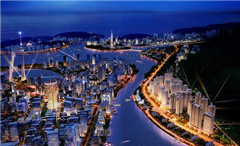Opportunities and challenges in realizing Greater Bay Area plan
2017-07-07
cgtn.com
At the mouth of China’s southern Pearl River is a rapidly expanding port. And that’s Guangzhou’s Nansha Port. It now has 16 container berths and can serve the largest container ships on earth.
This bustling, newly-established port shows the huge growth potential of the Great Bay Area, which already includes three of the world’s top 10 ports, namely Hong Kong, Shenzhen, and Guangzhou.
As a global trading power, the Pearl River Delta is only outranked by the US and Germany.
Song Xiaoming, the vice general manager of the Guangzhou Port, says the ports in Hong Kong, Shenzhen and Guangzhou already handle more goods, in terms of volume, than San Francisco, New York and Tokyo. But on the global value chain, they still need to catch up.
“Now the most profitable business in shipping is in the hands of the West,” said Song. “But if we can combine Hong Kong’s high-end financial services and the huge market on the mainland, with closer collaboration we can bargain for more leverage, when negotiating international shipment terms, to have more say in logistics.”
China’s new initiative for the Guangdong-Hong Kong-Macao area aims to turn the region into a more integrated world-class city cluster that is globally competitive.
Professor Xiao Geng from the University of Hong Kong said the Bay Area plan stood out because it included two different economies: The socialist system on the mainland and the capitalist one in Hong Kong and Macao.
“Just consider, if we can’t solve frictions under the principle of ‘One Country Two Systems’, how can we handle frictions associated with global trade?” Xiao said.
But there are still obstacles that can’t solved only by the efforts of Guangdong province, Hong Kong and Macao.
“Institutional innovation requires the determination of the central government,” said Professor Liang Qi from Sun Yat-Sen University, who is also an adviser to Guangdong’s Provincial Government and has been counseling officials on how to implement the Greater Bay Area plan.
“For instance, Hong Kong’s accountants cannot work in the mainland because their certification is not recognized here. We have to solve these kinds of issues to facilitate further integration,” said Liang.
He added that more effort and assistance from the central government is necessary in order to turn the framework for the Bay Area into a concrete action plan.



